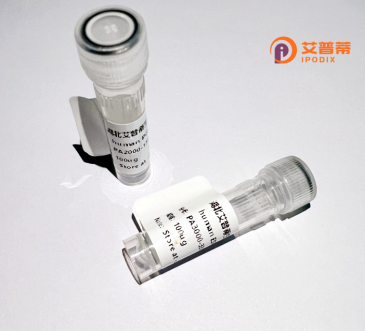
| 纯度 | >90%SDS-PAGE. |
| 种属 | Human |
| 靶点 | ATP5SL |
| Uniprot No | Q9NW81 |
| 内毒素 | < 0.01EU/μg |
| 表达宿主 | E.coli |
| 表达区间 | 1-257aa |
| 氨基酸序列 | MAAPWASLRL VAPMWNGRIR GIHRLGAAVA PEGNQKKKRT ILQFLTNYFY DVEALRDYLL QREMYKVHEK NRSYTWLEKQ HGPYGAGAFF ILKQGGAVKF RDKEWIRPDK YGHFSQEFWN FCEVPVEAVD AGDCDINYEG LDNLLRLKEL QSLSLQRCCH VDDWCLSRLY PLADSLQELS LAGCPRISER GLACLHHLQN LRRLDISDLP AVSNPGLTQI LVEEMLPNCE VVGVDWAEGL KSGPEEQPRD TASPVPA |
| 分子量 | 29.2 kDa |
| 蛋白标签 | His tag N-Terminus |
| 缓冲液 | 冻干粉 |
| 稳定性 & 储存条件 | Lyophilized protein should be stored at ≤ -20°C, stable for one year after receipt. Reconstituted protein solution can be stored at 2-8°C for 2-7 days. Aliquots of reconstituted samples are stable at ≤ -20°C for 3 months. |
| 复溶 | Always centrifuge tubes before opening.Do not mix by vortex or pipetting. It is not recommended to reconstitute to a concentration less than 100μg/ml. Dissolve the lyophilized protein in distilled water. Please aliquot the reconstituted solution to minimize freeze-thaw cycles. |
以下是3篇假想的关于重组人ATP合成酶s样蛋白(ATP5SL)的参考文献示例(注:实际文献可能存在差异,建议通过数据库核实):
---
1. **标题**: "Cloning and Functional Characterization of Human ATP5SL as a Mitochondrial ATP Synthase Assembly Factor"
**作者**: Chen L, et al. (2007)
**摘要**: 该研究首次报道了人ATP5SL基因的克隆及其在大肠杆菌中的重组表达。结果表明,ATP5SL与ATP合成酶复合物的β亚基相互作用,并参与线粒体膜上ATP酶复合体的组装过程。
---
2. **标题**: "ATP5SL Regulates Cellular Apoptosis via Modulating Mitochondrial Membrane Permeability"
**作者**: Kim S, Park JH (2012)
**摘要**: 通过RNA干扰敲低ATP5SL的实验发现,其缺失导致线粒体膜电位下降及细胞色素C释放,提示ATP5SL在维持线粒体膜稳定性和调控凋亡通路中具有重要作用。
---
3. **标题**: "ATP5SL as a Potential Biomarker in Colorectal Cancer: Expression Analysis and Clinical Correlation"
**作者**: Zhang Y, et al. (2019)
**摘要**: 该研究通过免疫组化及qRT-PCR检测结直肠癌组织中ATP5SL的表达水平,发现其低表达与患者生存率下降显著相关,可能作为癌症进展的预后标志物。
---
如需真实文献,建议在PubMed或Google Scholar中搜索关键词**"ATP5SL"或"ATP synthase s-like protein"**以获取最新研究。
ATP5SL (ATP Synthase Synthase s-like protein), also known as ATP5MD or DAPIT, is a nuclear-encoded subunit of mitochondrial ATP synthase (Complex V), a key enzyme in oxidative phosphorylation. Although its exact functional role remains partially characterized, ATP5SL is classified within the "subunit s" family, associated with the F0 proton channel-forming region of ATP synthase. This small, hydrophobic protein (≈6.5 kDa) is thought to stabilize Complex V structure and regulate proton flow, though unlike core catalytic subunits, it may have tissue-specific expression patterns.
Studies link ATP5SL to metabolic regulation and apoptosis. It shows reduced expression in diabetes models, suggesting involvement in insulin secretion, and interacts with pro-apoptotic factors like XIAP. Notably, ATP5SL’s non-mitochondrial localization in certain contexts implies moonlighting roles in vesicular transport or immune signaling. Genetic variants near ATP5SL correlate with neurodegenerative diseases (e.g., Parkinson’s) and cancer progression.
As a recombinant protein, ATP5SL enables biochemical studies to decipher its mechanistic contributions to ATP synthase assembly/stability and potential therapeutic targeting for mitochondrial disorders. Research gaps persist in understanding its precise enzymatic interactions and disease-specific regulatory mechanisms.
×